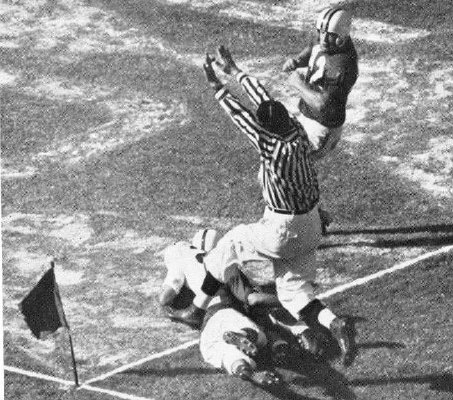


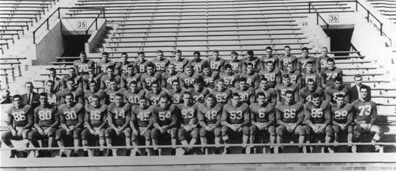
| at Oklahoma (9-1-1) | 28-21 | #2 |
| at Purdue (2-7) | 37-7 | |
| Pittsburgh (3-5-1) | 23-14 | |
| Georgia Tech (9-2-1) | 27-14 | #6 |
| Navy (4-3-2) | 38-7 | |
| at Penn (3-5-1) | 28-20 | |
| at North Carolina (4-6) | 34-14 | |
| Iowa (5-3-1) | 14-14 | #9 |
| at Southern Cal (6-3-1) | 48-14 | (#26) |
| Southern Methodist (5-5) | 40-14 |
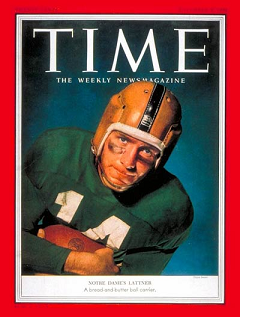 As I count them, this was Notre Dame's 8th MNC, following mythical titles in 1924, 1929, 1930, 1943, 1946, 1947, and 1949.
It need hardly be said that that is the most of any school 1901-1953.
During that time period, I have 4 schools behind Notre Dame with 6 MNC
each: Harvard, Yale, Michigan, and Minnesota. I covered Notre Dame's 1953 coach, Hall of Famer Frank Leahy, in the linked 1943
article. This was his 5th MNC in 11 seasons at Notre Dame, and I recognize his 1940 Boston College team as an MNC as well, giving him 6 MNCs in 13 years for his career. That is a championship rate that will never be topped (albeit mythical), and that's just as a head coach. He was the line coach for Fordham when they won an MNC in 1937 (and their famous line was the strength of the team), and he played for a pair of MNC Notre Dame teams in 1929 and 1930.
That's 9 MNCs he was a part of. But this year was the end of the
championship line for him, as he had to retire after this season for
health reasons.
As I count them, this was Notre Dame's 8th MNC, following mythical titles in 1924, 1929, 1930, 1943, 1946, 1947, and 1949.
It need hardly be said that that is the most of any school 1901-1953.
During that time period, I have 4 schools behind Notre Dame with 6 MNC
each: Harvard, Yale, Michigan, and Minnesota. I covered Notre Dame's 1953 coach, Hall of Famer Frank Leahy, in the linked 1943
article. This was his 5th MNC in 11 seasons at Notre Dame, and I recognize his 1940 Boston College team as an MNC as well, giving him 6 MNCs in 13 years for his career. That is a championship rate that will never be topped (albeit mythical), and that's just as a head coach. He was the line coach for Fordham when they won an MNC in 1937 (and their famous line was the strength of the team), and he played for a pair of MNC Notre Dame teams in 1929 and 1930.
That's 9 MNCs he was a part of. But this year was the end of the
championship line for him, as he had to retire after this season for
health reasons.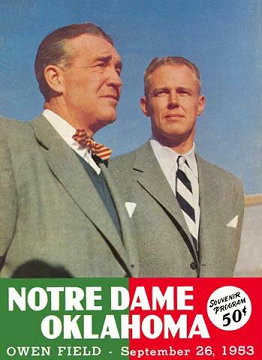
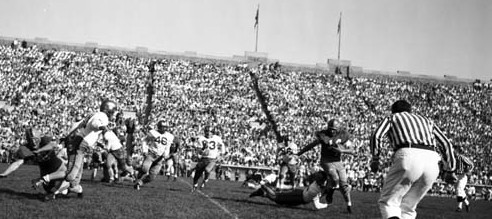
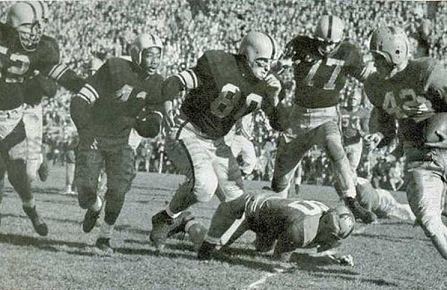
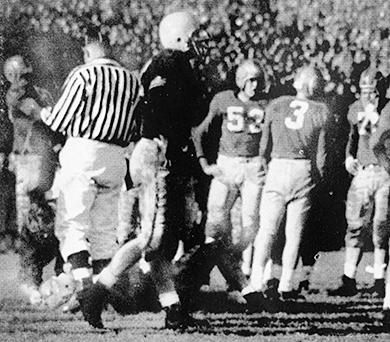
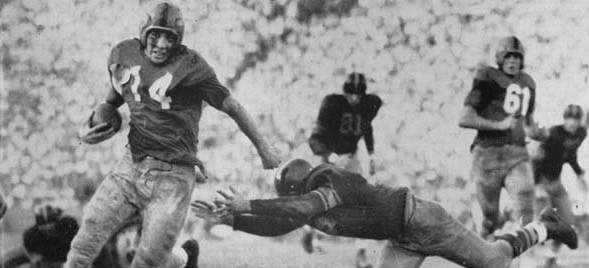
| 1) DeVold
(math system) |
4.95 |
| 2) National Championship Foundation | 4.80 |
| 3) Billingsley (math) | 4.72 |
| 4)
College
Football Researchers Association | 4.63 |
| 5) Houlgate (math) | 4.53 |
| 6) Dunkel (math) | 4.51 |
| 7) Poling
(math) |
4.49 |
| 8) Boand (math) | 4.45 |
| 9) Sagarin-ELO (math) | 4.41 |
| 10) Litkenhous
(math) Sagarin (math) |
4.21 |
| 12) AP Poll | 4.12 |
| 13) Helms Foundation | 3.99 |
| 14) Williamson (math) | 3.52 |
| 15) Berryman (math) | 3.51 |
| 1) Boand (math system) | 4.26 |
| 2) College Football Researchers Association | 4.22 |
| 3) Poling (math) | 4.11 |
| 4) Helms | 4.09 |
| 5) Sagarin-ELO (math) | 4.06 |
| 6) National Championship Foundation | 3.96 |
| 7) Dickinson (math) | 3.49 |
| 8) Houlgate (math) | 3.35 |
| 9) Billingsley (math) | 3.34 |
| 10) Sagarin (math) | 3.28 |
| 11) Parke Davis | 2.77 |
| 1) Houlgate (math system) | 4.5 |
| 2) Helms | 4.3 |
| 3) Parke Davis | 4.2 |
| 4) National Championship Foundation | 3.7 |
| 5) Billingsley (math) | 3.6 |